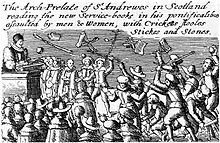
Back إسكتلندا في حروب الممالك الثلاث Arabic Rhyfel Cartref yr Alban Welsh Schottland in den Kriegen der drei Königreiche German Escocia en las Guerras de los Tres Reinos Spanish 스코틀랜드 내전 Korean Гражданская война в Шотландии Russian Scotland in the Wars o the Three Kinricks SCO Шкотски рат (1639—1651) Serbian
This article has multiple issues. Please help improve it or discuss these issues on the talk page. (Learn how and when to remove these messages)
|
| Scotland in the Wars of the Three Kingdoms | ||||||||
|---|---|---|---|---|---|---|---|---|
| Part of the Wars of the Three Kingdoms | ||||||||
 Riot sparked by Jenny Geddes over the imposition of Charles I's Book of Common Prayer in Presbyterian Scotland. Civil disobedience soon turned into armed defiance. | ||||||||
| ||||||||
| Belligerents | ||||||||
|
|
| |||||||
| Commanders and leaders | ||||||||
|
|
| |||||||
| Strength | ||||||||
| Fluctuating, 2,000–4,000 troops at any one time | Over 30,000 troops, but many based in England and Ireland | |||||||
| Casualties and losses | ||||||||
| Total of 28,000 battlefield deaths on both sides, more soldiers die from disease, c. 45,000 civilian deaths, both from disease and deliberate targeting | ||||||||
Between 1639 and 1652, Scotland was involved in the Wars of the Three Kingdoms, a series of conflicts which included the Bishops' Wars, the Irish Rebellion of 1641, the English Civil War, the Irish Confederate Wars and finally the conquest of Ireland and the subjugation of Scotland by the English New Model Army.
Within Scotland, from 1644 to 1645 a Scottish civil war was fought between Scottish Royalists—supporters of Charles I under James Graham, 1st Marquess of Montrose—and the Covenanters, who had controlled Scotland since 1639 and who were allied with English Parliamentarians. The Scottish Royalists, aided by Irish troops, had a rapid series of victories in 1644–45, but were eventually defeated by the Covenanters.
The Covenanters then found themselves at odds with the English Parliament, so they crowned Charles II at Scone and thus stated their intention to place him on the thrones of England and Ireland as well. In 1650, Scotland was invaded and occupied by the New Model Army under Oliver Cromwell.